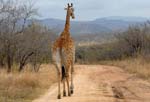
Into the Wild
Largest game reserve in South Africa implements anti-poaching surveillance system.
On a typical day at Kruger National Park, the
largest game reserve in South Africa, visitors
on safari will encounter the Big Five—lions,
African elephants, Cape buffalo, leopards and black
rhinoceros—living in their natural habitat. In addition
to the 147 species of mammals—more than any other
African game reserve—the park is home to more than
500 bird and almost 2,000 flower and tree species.
The park spans more than 7,000 square miles, has
eight main entrances and features six ecosystems.
Accommodations vary from rustic camping to modern
and luxurious lodgings. The park is best known
as a self-drive destination and annually welcomes
2 million day visitors alone.
Security Challenges
In stark contrast to the natural harmony of the reserve,
almost 250 animals, including the critically endangered
white rhinos, have been poached in the last
few years.
"Poaching is our main focus," said Mbongeni M.
Tukela, acting regional manager of SANParks, in a
press release. "We have communities on the boundaries
with low employment so they look to the park
for ways to sustain themselves. They go for game to
sell—there is a big market for bush meat—anything
from warthog to impala or bigger bucks, kudu, even
buffalo and giraffe. This is more of a problem than
rhino and elephant ivory."
In addition to poaching, another problem plaguing
the park is animal fatalities caused by speeding
cars. The park has set strict speed limits, but the problem
remains.
The Integrated Solution
The income generated from Kruger National Park is
used to sustain conservation efforts in more than 20
other parks in South Africa, which means successful
management of this expansive park and the continued
success of tourism are crucial.
To ensure the park's continued success, officials
needed to implement a surveillance system to discourage
poachers and speeders.
Milestone Certified Partner Camsecure installed
Milestone Systems' XProtect Enterprise IP video
management software to manage Axis PTZ network
cameras, which are positioned at the main gates and
throughout the various camps in the park.
XProtect Enterprise is designed to support large
multi-server, multi-site installations with unlimited
cameras. The software easily controls the Axis PTZ
network cameras' movements via a computer connected
to the network.
Park management can centrally access live camera
views and play back video of up to 64 cameras from
multiple servers simultaneously from Skukuza, the
park's administrative headquarters.
Security at the Gates
The park's gates are the first line of security. Axis
cameras are positioned to capture license plate numbers
and whole-car images. Admission guards register
all vehicles and keep count of the number of people
in each vehicle.
"We check that the number of people entering and
exiting the gates is the same in each vehicle—that no
one who entered has left on foot to smuggle poached
bush meat," Tukela said. "The boundary with Mozambique
alone is more than 150 kilometers and porous
with no fences."
Stopping Speeders
Visitors and staff both have roles to play in the safety
of the animals. In addition to patrols, park staff relies
upon vigilant visitors to report speeding drivers and
suspicious activity.
With the integrated system, if an animal is hit by a
car, park managers can query video around the time
and location of the accident. Once they identify and
locate the suspected vehicle, they can track it until
park officials can intervene and take necessary action.
For further evidence, the Axis cameras deliver
clear images of any dents and management can compare
videos of the suspected vehicle before and after
the accident.
Thwarting Thefts
Due to cases of armed robberies and thefts perpetuated
by staff members, cameras now also monitor every
cash register and ATM machine to ensure the safety
of visitors. Employees are aware that park managers
are able to remotely watch over them and can zoom in
on transactions.
The cameras also improve customer service.
"Sometimes, I pick up the phone and ask, "Why
are you not attending to the guests?" Tukela said. "So,
they know I am watching."
With the Milestone-Axis infrastructure in place,
Kruger National Park now has an effective counterpoaching
strategy, and park officials can focus on
conservation efforts and providing their guests with
a wild experience.
About the Author
Sherleen Mahoney is a Web managing editor at 1105 Media.